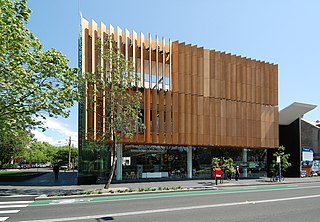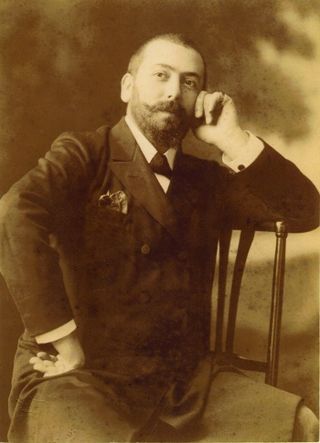Related Research Articles

Andrew Barton "Banjo" Paterson, was an Australian bush poet, journalist and author, widely considered one of the greatest writers of Australia's colonial period.
The following is an overview of the events of 1896 in film, including a list of films released and notable births.

Surry Hills is an inner-east suburb of Sydney, in the state of New South Wales, Australia. Surry Hills is immediately south-east of the Sydney central business district in the local government area of the City of Sydney. Surry Hills is surrounded by the suburbs of Darlinghurst to the north, Chippendale and Haymarket to the west, Moore Park and Paddington to the east and Redfern to the south. It is often colloquially referred to as "Surry".

Manly is a beach-side suburb of northern Sydney, in the state of New South Wales, Australia. It is 17 kilometres (11 mi) north-east of the Sydney central business district and is currently one of the three administrative centres of the local government area of Northern Beaches Council. Manly has a long-standing reputation as a tourist destination, owing to its attractive setting on the Pacific Ocean and easy accessibility by ferry.

Annette Marie Sarah Kellermann was an Australian professional swimmer, vaudeville star, film actress, and writer, usually known as Annette Kellerman.
The following lists events that happened during 1885 in Australia.

Until Australia became a Federation in 1901, each of the six colonies was responsible for its own defence. From 1788 until 1870 this was done with British regular forces. In all, 24 British infantry regiments served in the Australian colonies. Each of the Australian colonies gained responsible government between 1855 and 1890, and while the Colonial Office in London retained control of some affairs, and the colonies were still firmly within the British Empire, the Governors of the Australian colonies were required to raise their own colonial militias. To do this, the colonial Governors had the authority from the British crown to raise military and naval forces. Initially these were militias in support of British regulars, but British military support for the colonies ended in 1870, and the colonies assumed their own defence. The separate colonies maintained control over their respective militia forces and navies until 1 March 1901, when the colonial forces were all amalgamated into the Commonwealth Forces following the creation of the Commonwealth of Australia. Colonial forces, including home raised units, saw action in many of the conflicts of the British Empire during the 19th century. Members from British regiments stationed in Australia saw action in India, Afghanistan, the New Zealand Wars, the Sudan conflict, and the Boer War in South Africa.

The 1st Light Horse Brigade was a mounted infantry brigade of the Australian Imperial Force (AIF), which served in the Middle Eastern theatre of World War I. The brigade was initially formed as a part-time militia formation in the early 1900s in New South Wales and then later in Queensland. In 1914, the brigade was re-constituted as part of the AIF and was sent to Egypt. Forming part of the New Zealand and Australian Division, during the Gallipoli Campaign it served in a dismounted role between May and December 1915. After being withdrawn to Egypt it served in the Anzac Mounted Division from March 1916 as part of the Egyptian Expeditionary Force, taking part in the Sinai and Palestine Campaign until the end of the war. It was disbanded in 1919. After the war, the AIF light horse regiments were demobilised and disbanded; however, the brigade briefly existed as a part-time militia formation in Queensland until 1921 when its regiments were reorganised into cavalry brigades.

The 3rd Light Horse Brigade was a mounted infantry brigade of the Australian Imperial Force (AIF), which served in the Middle Eastern theatre of World War I. The brigade was initially formed as a part-time militia formation in the early 1900s in Victoria. In 1914, the brigade was re-constituted as part of the AIF. The brigade first saw action while serving with the Australian and New Zealand Army Corps during the Gallipoli campaign where they were noted for their attack during the Battle of the Nek. After being withdrawn to Egypt in February 1916 they were involved in the Sinai and Palestine Campaign until the end of the war. They were attached to a number of different formations being part of the Anzac Mounted Division in March 1916 and the Australian Mounted Division in June 1917, who they remained with until the end of the war. After the war, the AIF light horse regiments were demobilised and disbanded; however, the brigade briefly existed as a part-time militia formation in New South Wales until 1921 when its regiments were reorganised into cavalry brigades.

The 4th Light Horse Brigade was a mounted infantry brigade of the Australian Imperial Force (AIF) serving in the Middle Eastern theatre of World War I. The brigade was initially formed as a part-time militia formation in the early 1900s in Victoria and Tasmania. After the outbreak of World War I, the brigade was raised as a volunteer formation within the AIF in March 1915 and shipped to Egypt and was broken up in August 1915 to provide dismounted reinforcements to other light horse formations already deployed to Gallipoli. Reformed in February 1917, the brigade was assigned to the Imperial Mounted Division, which formed part of the Egyptian Expeditionary Force, and in June 1917 transferred to the Australian Mounted Division, where it served in the Sinai and Palestine Campaign until the end of the war. After the war, the AIF light horse regiments were demobilised and disbanded; however, the brigade briefly existed as a part-time militia formation in New South Wales until 1921 when its regiments were reorganised into cavalry brigades.
Into the Straight is a 1949 Australian horse racing melodrama directed by T. O. McCreadie.

Major-General James Alexander Kenneth Mackay,, usually known as Kenneth Mackay, was an Australian soldier and politician.

Manly Wharf is a heritage-listed passenger terminal wharf and recreational area located at West Esplanade and serving Manly, a Sydney suburb in the Northern Beaches Council local government area of New South Wales, Australia. Since the 1850s, it has served as the Manly embarkation and disembarkation point for the Manly to Sydney ferry service.

Henry Walter Barnett, usually known as H. Walter Barnett, was an Australian photographer and filmmaker. Barnett was a prominent portrait photographer of the late 19th and early 20th centuries, establishing the successful Falk studios in Sydney. Later in his career he was based in London, England, with studios at Hyde Park Corner and Knightsbridge. Barnett became involved in filmmaking after meeting cinematographer Marius Sestier in 1896, and with Sestier made some of the first films shot in Australia.

Marius Ely Joseph Sestier was a French cinematographer. Sestier was best known for his work in Australia, where he shot some of the country's first films.
The 1896 Melbourne Cup was a two-mile handicap horse race which took place on Tuesday, 3 November 1896.
The Melbourne Cup was a film about the two mile horse race won by Newhaven which took place on Tuesday, 3 November 1896.

Patineur Grotesque was a film of a comic roller-skater.

Passengers Alighting from Ferry Brighton at Manly is an 1896 film by Marius Sestier of passengers alighting from the paddle steamer ferry Brighton at Manly Wharf in Sydney. It is the first film ever shot and screened in Australia. Sestier and Henry Walter Barnett made approximately 19 films in Sydney and Melbourne between October and November 1896, of which this was the earliest.
Newhaven was an Australian bred Thoroughbred racehorse who won the 1896 Victoria Derby and the 1896 Melbourne Cup carrying a record weight for a 3 year old of 7st.13lb by 6 lengths.
References
- 1 2 Martin-Jones, Tony. "Marius Sestier in Australia". apex net au. Retrieved 18 October 2020.
- ↑ "THE LUMIERE CINEMATOGRAPHE". The Daily Telegraph . No. 5448. New South Wales, Australia. 5 December 1896. p. 11. Retrieved 18 October 2020– via National Library of Australia.